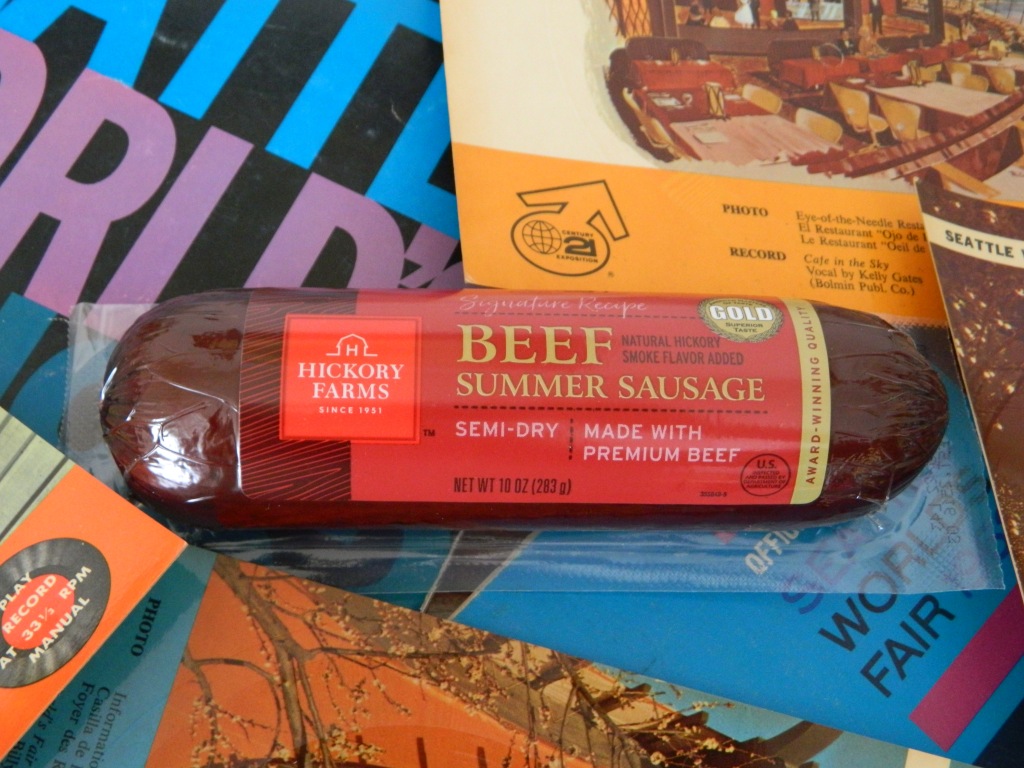Welcome back, and happy summer!
What comes to mind when you think of Hickory Farms? I think most people would associate this brand with Christmastime and shopping malls, but the brand actually started as a vendor at fairs.
The year was 1951 when Ohioan cousins Richard and Earl Ransom began selling handmade cheeses at local fairs. The Ransoms had started a produce market in the previous decade, but the work was very seasonal and they wanted something to do in the off season. Five years later, the beef stick (now beef summer sausage) was introduced. By 1959 the company was selling 1.5 million pounds of beef stick via fair booths and mail order annually. That same year, the company was dubbed Hickory Farms, and its first storefront opened in Toledo, Ohio.
The store featured a strong farm theme, free coffee, and lots of free samples, all of which aimed to encourage shoppers to linger and buy. It must have worked, because the first Hickory Farms franchise store opened in 1960. The company officially incorporated that same year.
By 1965, there were 57 Hickory Farms stores in operation. By 1968, that number had risen to 100. Despite the success of its stores, Hickory Farms continued to rent booths at fairs. By 1964, the company claimed to have more spaces at fairs and expos than any other company.
Around this time, the company’s products became exceptionally popular around Christmastime, with 40% of annual sales occurring during the holiday season.
Hickory Farms went public in 1970, at the start of a decade that would spell explosive growth for the company. By 1975, Hickory Farms boasted over 300 stores across 43 US states and Canada. Ransom rekindled the original booth strategy in 1977, this time targeting mall kiosks rather than fair booths. Hickory Farms finished off the 70s strong, with a total revenue of more than $164 million.
In 1980, Ransom sold to General Host (GH) Corporation (remember them from the Bar S history?) for $40 million. GH also purchased the company’s largest franchisee, Hickory Farms Sales, for $11 million. Despite their hopes that Hickory Farms wild success would continue under their management, that was not the case. While multiple things were blamed for this downturn (including poor management, declining mall traffic, and even HoneyBaked Ham), GH decided to turn its primary focus to its chain of gardening stores and divest several of its other interests, including Hickory Farms.
In 1987, in a turn of events strangely similar to the story of Bar S Meats, Hickory Farms was sold to a group of investors headed by Robert DiRomualdo, who had succeeded Richard Ransom as CEO of Hickory Farms several years prior. DiRomualdo is credited with helping the company get back on its feet and return to profitability. Despite his successes, he abruptly resigned in the early 90s.
Under new leadership, Hickory Farms sought to increase its number of company-owned stores by buying up franchised locations from aging franchisees. One of the largest acquisitions was Hickory Farms Northwest, which operated 14 locations in Washington and Oregon.
Throughout the 90s, Hickory Farms acquired several other food companies, expanding their product offerings to include nuts, fruits, steaks, seafoods, and other giftable delicacies. The mail-order option, which had been discontinued in the 70s, was brought back, along with the focus on locations in shopping malls.
Today, Hickory Farms remains popular as a holiday gift. Its giftsets can be purchased directly from the company, at one of its pop-up stores, or even on Amazon. I purchased the above summer sausage at the deli department of my local Fred Meyer.
Now get out and enjoy that sun! I’ll see you next week for another recipe.
